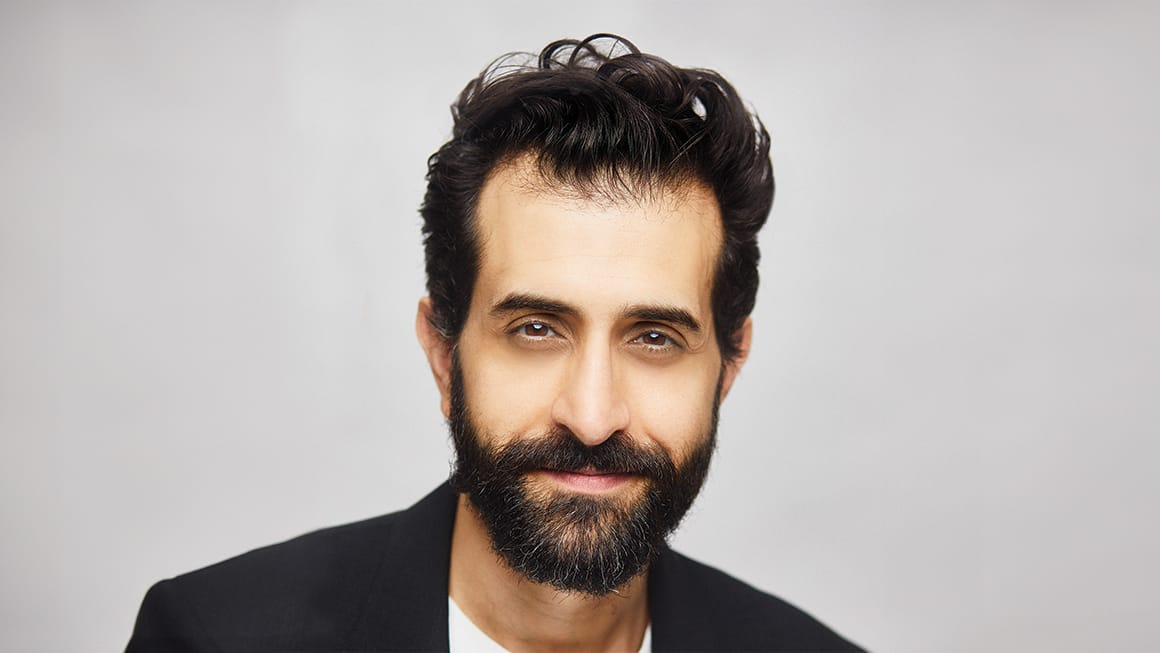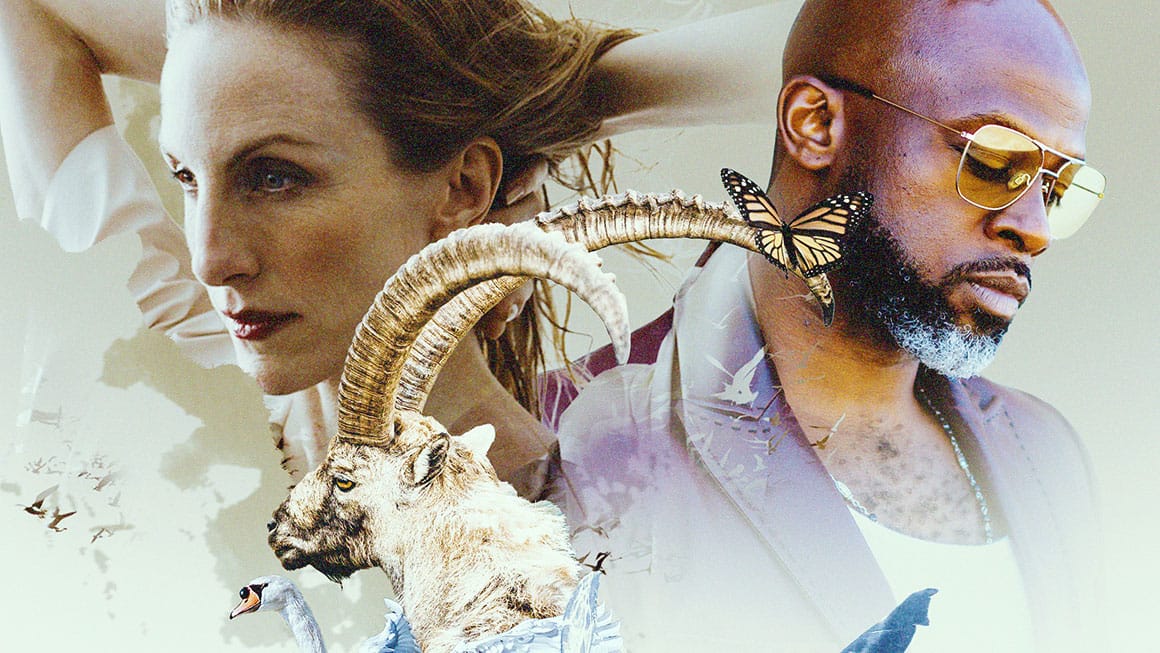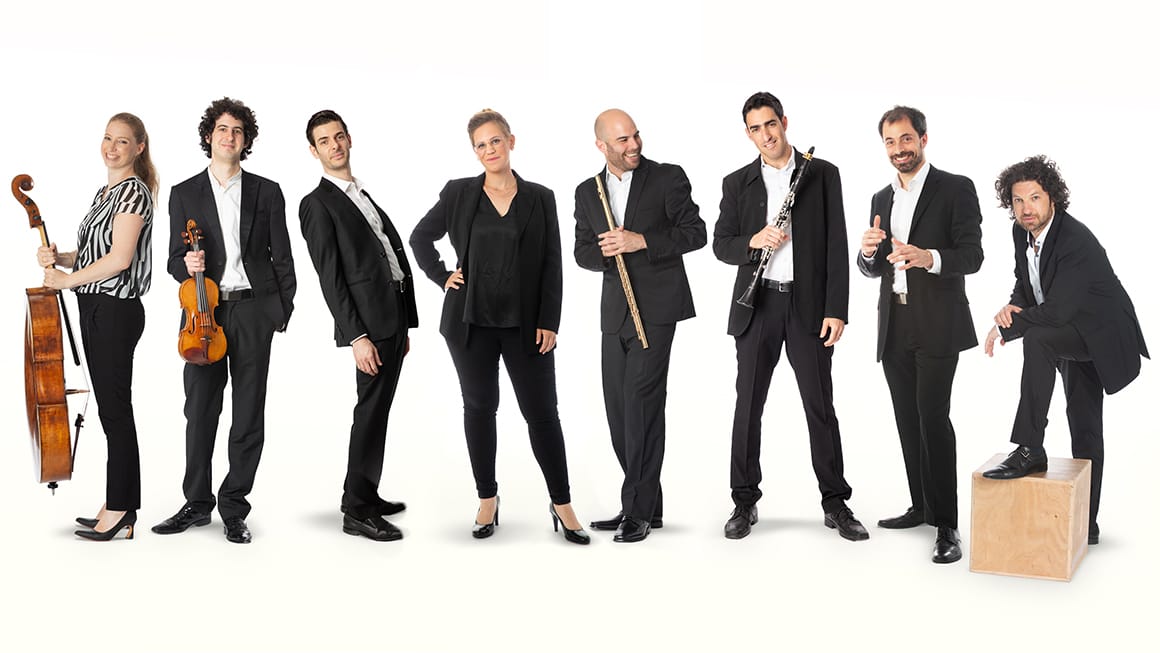Chamber Music Series April 16 | 7:30 p.m.
Chamber Music Series
Israeli Chamber Project with Karim Sulayman
April 16 | 7:30 p.m.
Karim Sulayman, tenor
Carmit Zori, violin
Kobi Malkin, violin
Guy Ben-Ziony, viola
Michal Korman, cello
Tibi Cziger, clarinet
Sivan Magen, harp
Assaff Weisman, piano
ROBERT SCHUMANN
(1810–1856)
Three Fantasy Pieces, Op. 73
(arranged by Jonathan Keren for clarinet and string quartet)
NAJI HAKIM
(b. 1955)
The Dove — for tenor and string quartet
ZOHAR SHARON
(b. 1976)
The Ice Palace*
1. Prelude
2. Slowly Freezing Drops
3. On the way to meet Unn — Nocturne
4. Sparkling Flashes in the Mirror
5. Inside the Ice Palace — The Room of Tears
INTERMISSION
CLAUDE DEBUSSY
(1862–1918)
Sacred and Profane Dances — for harp and string quartet
GITY RAZAZ
(b. 1986)
Flowing Down the Widening Rings of Being*
1. Limits of Longing
2. The Tree of Awe
3. Dance
4. Endless Song
5. A Community of the Spirit
SAMUEL BARBER
(1910–1981)
Knoxville: Summer of 1915
(arranged by Yuval Shapiro)
*Commissioned for the Israeli Chamber Project by the Adele and John Gray Endowment Fund.
Series Sponsors
generously underwritten by
Cecilia Paul & Harry Reinert and Eric & Margaret Rothchild
SEASON SUPPORT COMES FROM
Microsoft
Artsfund
Nesholm Family Foundation
Horizons Foundation of Washington
Seattle Office of Arts and Culture
4Culture
MEDIA PARTNER
Classical KING FM 98.1
YOUTH MATINEE UNDERWRITTEN BY
Ladies Musical Club
Peg & Rick Young Foundation
Hans & Kristin Mandt
SIGNATURE SUPPORT
The Robert Craft Igor Stravinsky Foundation
ADDITIONAL SUPPORT COMES FROM
Warren & Anne Anderson
Sylvia & Stephen Burges
Helen Curtis
Katharyn Alvord Gerlich
Daniela & Torsten Grabs
Lynn & Brian Grant Family
M. Elizabeth Halloran
Hsiao-Wuen & Tiffany Hon
Mary & Gifford Jones
Matthew & Christina Krashan
Jeffrey Lehman & Katrina Russell
Hans & Kristin Mandt
Rebecca Norton & Craig Miller
Eric & Margaret Rothchild
Don & Toni Rupchock
Craig Sheppard & Gregory Wallace
John C. Robinson & Maya Sonenberg
Dave & Marcie Stone
Don & Gloria Swisher

About the Artist
About the Israeli Chamber Project
Now in its second decade, the Israeli Chamber Project is a dynamic ensemble comprising strings, winds, harp and piano, that brings together some of today’s most distinguished musicians for chamber music concerts and educational and outreach programs both in Israel and abroad. It was named the winner of the 2011 Israeli Ministry of Culture Outstanding Ensemble Award and the 2017 Partos Prize in recognition of its passionate musicianship, creative programming and commitment to educational outreach.
Based both in Israel and in New York, the ensemble was created as a means for its members to give something back to the community where they began their musical education and to showcase Israeli culture, through its music and musicians to concert goers overseas. Among its members are prize-winners at the Tchaikovsky International Competition in Russia, the Borletti-Buitoni Trust Award, Avery Fisher Career Grant and the Gaspar Cassado Cello Competition.
The Israeli Chamber Project’s tours have garnered rave reviews and established the ensemble as a major artistic force on both sides of the Atlantic. These tours include appearances on some of the premier chamber music series, whether in Jerusalem, Tel Aviv, New York or Beijing, as well as in remote towns where access to live chamber music is extremely rare. Guest artists on ICP tours have included the Guarneri String Quartet’s Michael Tree and Peter Wiley, the Cleveland Orchestra’s Principal Flutist Joshua Smith, as well as international soloists Antje Weithaas, Liza Ferschtman and Marina Piccinini.
A strong advocate for music education, the ICP has partnered with several conservatories and educational institutions in order to offer lessons and masterclasses to students of all cultural and economic backgrounds, many of whom have little or no opportunity to work with internationally recognized musicians.
An important part of the Israeli Chamber Project’s mission is to expand the chamber music literature by commissioning both new works as well as new arrangements of existing works. Original commissions have included works by Lowell Liebermann, Matan Porat, Jonathan Keren, Gilad Cohen, Yohanan Chendler, Amit Gilutz and Zohar Sharon. New arrangements of works by Debussy, Ravel, Barber, Stravinsky, Schumann and Bernstein created by Yuval Shapiro, Jonathan Keren and Sivan Magen have become a cornerstone of the ensemble’s programming.
The Israeli Chamber Project has appeared at venues including London’s Wigmore Hall, Weill Recital Hall at Carnegie Hall, the Morgan Library & Museum, Town Hall and Merkin Concert Hall in New York City, Philadelphia’s Kimmel Center, Herbst Theatre in San Francisco, The Clark Memorial Library at UCLA, Ottawa’s Chamberfest, on tour in China and Hong Kong, and has been featured on NPR’s Performance Today and WQXR’s Young Artist Showcase.
Notable performances in the 2023–24 season include the ensemble’s first collaboration with the preeminent violist, Tabea Zimmermann as well as the world premiere of a new Gity Razaz commission written for the ensemble and tenor Karim Sulayman.
About Karim Sulayman
Lebanese American tenor Karim Sulayman has garnered international attention as a sophisticated and versatile artist, praised for his “lucid, velvety tenor and pop-star charisma” (BBC Music Magazine). He earns widespread acclaim for his innovative programming, recording projects and performances on the world’s stages in opera, orchestral concerts, recital and chamber music.
Recent seasons have included engagements at Carnegie Hall, Spoleto Festival USA, Opera Philadelphia, Wigmore Hall, Aldeburgh Festival, Hamburg’s Elbphilharmonie, Stockholm’s Drottningholms Slottsteater, Houston Grand Opera, Australian Brandenburg Orchestra, the Chicago, National and Pittsburgh Symphony Orchestras, and the Ravinia and Schleswig Holstein Musik Festivals.
This season’s engagements include his debut at the Royal Opera House as the title role in Sarah Angliss/Ross Sutherland’s Giant, the world premiere of Layale Chaker/Lisa Schlesinger’s Ruinous Gods and Haydn’s Creation at the Spoleto Festival USA, debuts with New World Symphony, Boston Celebrity Series and Boston Baroque, and return engagements with Phillips Collection and CAP UCLA. Upcoming seasons include returns to Wigmore Hall and Schleswig Holstein Musik Festival, debuts with San Francisco Performances and the Park Avenue Armory, and the world premiere of David T. Little’s monodrama, What Belongs to You (based on Garth Greenwell’s acclaimed novel), written for Sulayman and Alarm Will Sound, directed by Mark Morris.
Mr. Sulayman won the 2019 Grammy Award for Best Classical Solo Vocal Album for his debut solo disc, Songs of Orpheus (Avie Records). His second album, Where Only Stars Can Hear Us (Avie Records) with fortepianist Yi-heng Yang, debuted at #1 on the Billboard Traditional Classical Chart and was included in The New York Times’ Best Classical Music of 2020. His third solo album, Broken Branches (Pentatone), with guitarist Sean Shibe, debuted at #1 on the UK Classical Chart and was nominated for the 2024 Grammy Award for Best Classical Solo Vocal Album and was named one of the Best Classical Albums of 2023 by The New York Times.
About the Program
Three Fantasy Pieces, Op. 73
ROBERT SCHUMANN
In the late 1840s and early 1850s, Robert Schumann wrote several sets of pieces for one or two instruments and piano that are generally shorter than formal sonata movements and have such fanciful titles as Romances, Fairy Tales, and Folk Pieces. Most of them can be played by a variety of instruments. Schumann used the title Fantasiestücke or Phantasiestücke repeatedly for various piano compositions as well as for several chamber works. He conceived the Fantasiestücke, Op. 73, for clarinet and piano; in the manuscript, Schumann called them Soirée-stücke or “Party Pieces.” Though they were originally intended for clarinet and piano, Schumann directed that the clarinet part could be also performed on violin or cello. He sketched them in two or three days of February 1849, and they had taken final enough form that his wife Clara, who was one of the great pianists of the time, played them in their home in Dresden with the clarinetist of the court orchestra. Later that year, Schumann published them with cello as an equal alternative choice to the clarinet.
In this work, the clarinet substitutes for the human voice in a kind of song-like free lyric flow. Schumann indicated that the three poetic short pieces be played without pause. The first, Zart und mit ausdruck, a pensive, symmetrical work, has a tender and expressive demeanor in a minor tonality; the second, Lebhaft, leicht, lively and light, is spirited and written in the more optimistic key of A major; and the third, Rasch und mit Feuer, quick and fiery, displays high enthusiasm almost to the point of agitation. Schumann wrote the last two in major keys. The three works all have a similar structure; they all make use of the da-capo form, which means from the “head” or back to the beginning; they have a shape that could be diagrammed as ABA, with a return to an exact repeat of the piece for the final section. Each of the last two pieces also has a coda. The common key of A links all three pieces.
In this arrangement, a string quartet replaces the piano.
The Dove — for tenor and string quartet
NAJI HAKIM
Die Taube (The Dove) was commissioned by “Kirchenmusik bei St. Anna Augsburg” to celebrate the 450th anniversary of the “Augsburger Religionsfrieden” (Religious peace of Augsburg). It premiered in August 2005 at the Festkonzert zum Hohen Friedensfest by Robert Sellier, tenor, and Capella St. Anna Streichquartett.
Based on three biblical verses related to peace, the music is through-composed and develops the character of the verses with contrasted string textures, putting in relief the expressive vocal line, declamation of light and happiness. The work exists in three versions: for tenor and string quartet; for tenor and string orchestra; and for tenor and organ.
Genesis 8:11 — “And the dove came unto to him in the evening; and, lo, in her mouth was an olive leaf pluckt off.”
Luke 1:79 — “To give light to them that sit in darkness and in the shadow of death, to guide our feet into the way of peace.”
John 14:27 — “Peace I leave with you, my peace I give unto you. “
Words and music bind people together to form fellowships which guide us into the way of peace. Singing or playing together combine bodies and souls, so that our rhythm and breathing becomes one — a sense of belonging to one another is created which instils the very nature of peace. So it is that by becoming an integral part of the music, our feet are guided “into the way of peace.” In Luke chapter 1, both Maria and Zechariah are carried away, body and soul, in hymns of thanksgiving. They let God’s melody resound in their bodies. Ignatius, one of the Early Fathers of the Church, might have drawn his inspiration from them when he wrote to the Christians of Ephesus around the year 100, “Let God’s melody resound in you.” The melody of our life is a single voice within God’s great melody; an everlasting celestial melody, in which we join together as integral parts — with time, we are gradually shown which chords we are given to touch and which chords to form with one another.
God’s inextinguishable melody has an infinite galaxy of variations. As you would know, a variation is rooted but limitless. At our christening, God gives us a variation – an inextinguishable variation because of his promise, “I am with you always, even to the end of the age.” (Matthew 28, 20).
Deeply rooted as we are, God leads us through. He calls us to Life out of His Eternity, He lets his melody reverberate in us and finally calls us back, when we die, to His everlasting future. Let God ́s melody resound in you and guide your feet into the way of peace.
— Pastor Hanne Margrethe Tougaard
The Ice Palace
ZOHAR SHARON
Zohar Sharon’s The Ice Palace is based on the eponymous 1963 novel by Norwegian author Tarjei Vesaas, considered a classic of Norwegian literature. The story of Siss and Unn, two young girls living in a remote Norwegian village, deals with issues of loss, isolation and coming-of-age, and captured Mr. Sharon’s imagination when he first read it. He writes: “A dream that was born nearly ten years ago. On a scorching summer, while in Israel’s Arava desert, I read The Ice Palace with bated breath. I took in the foreign northern air, the mysterious icy landscape, and the quiet drama that unfolds beneath its surface. The book immediately inspired me to compose a piece, and after several failed attempts, the work finally came together for the Israeli Chamber Project.”
— Zohar Sharon
Sacred and Profane Dances — for harp and string quartet
CLAUDE DEBUSSY
Debussy was the creator and leading exponent of French musical impressionism. He began the study of piano at the age of nine, entering the Paris Conservatory to study piano with Marmontel and composition with Ernest Guiraud. From 1887 on, he confined his activity to composition, rarely performing the piano in public. Although he associated very little with other musicians, he met the leading Impressionist poets and painters frequently at gatherings at the home of the poet, Stephane Mallarmé. The work of Mallarmé and the Impressionists is an influence that is readily apparent in Debussy’s first important orchestral work, Prelude to the Afternoon of a Faun, inspired by Mallarmé’s poem called The Afternoon of a Faun. This work laid the foundation for Debussy’s own style of impressionist music and initiated his most productive period, which lasted nearly twenty years and saw the composition of his orchestral suites, an opera, Pelléas et Mélisande, and most of his piano music.
Debussy’s style was one of the most important influences on the evolution of early 20th century music. Even as a student, he refused to yield to the rules of traditional music theory. Later he stated, “There is no theory. You have only to listen. Pleasure is the law.” Preferring understated effects, he rejected the overblown forms and the harmonic style of the post-Wagnerians, such as Mahler and Bruckner. He wanted his music to sound almost improvisatory, as though it had not been written down.
Gustave Lyon, the director of Pleyel, the firm which had recently developed a new type of chromatic harp with strings arranged in two rows that corresponded to the natural keys of the piano in one row and to the chromatic keys in the other, commissioned Danse sacrée et danse profane in 1904. The harps used until then had been double-action harps. To sound the chromatic notes on these, the use of pedals was necessary. Debussy created this two-part work for chromatic harp and string orchestra. The Brussels Conservatory used it as a test piece even before it received its premiere at the Concerts Colonne in Paris. This composition had the effect of spurring other composers to write for this newly improved instrument. Ravel wrote an Introduction and Allegro and a less well-known composer, Florent Schmitt, wrote an Andante and Scherzo.
The composition grew from Debussy’s own idea of classical Greek dance. (Actually, little or nothing of Greek music is either extant or understood). Noble in tone and very poetic, it is a brief work and the only work Debussy ever wrote for a chamber group. The two dances that make up the work differ from each other in tempo as well as in their harmonic coloration. Chords in parallel movement distinguish the first, Danse sacrée, while the second, Danse profane is replete with dissonance and cascading arpeggios.
Flowing Down the Widening Rings of Being
GITY RAZAZ
The song cycle Flowing Down the Widening Rings of Being is the setting of a few poems by Austrian poet Rainer Maria Rilke and Sufi mystic Rumi.
Rumi and Rilke lived about 800 years apart and on nearly opposite sides of the earth, yet their perspective on some of the most existential topics in the history of mankind is eerily similar. One of the most apparent differences between the two poets (essentially both mystics) is felt in how they expressed their beliefs: Rilke is an introspective poet, his writings display the depth of his quest but also a gentle, relatable vulnerability. Rumi is almost the other extreme altogether, as he writes from a place of ecstasy and unearthly exultation, as if in the midst of an out-of-body experience. Sometimes in the attempt to translate his poem’s euphoria however, we lose sight of the subtlety and nuance of the original language. In their own ways, both Rilke and Rumi’s poems therefore allow great opportunities for musical settings.
— Gity Razaz
Knoxville: Summer of 1915
SAMUEL BARBER
Samuel Barber was one of the most distinguished members of the generation of American composers that came to maturity shortly before the Second World War. He began his musical studies when he was only six years old, and at seven, he was already composing. At fourteen, he entered the Curtis Institute of Music, and at twenty-one, he joined its faculty. Barber’s music was always firmly rooted in the traditional vocabulary and technique he learned at Curtis, which did not hamper him from composing works of great fantasy and expressivity. His music is rich in texture, free in rhythm and always melodic. Among his works are two full-length operas, two symphonies and three concertos.
Among the early admirers of Barber’s gifts was the conductor, Serge Koussevitzky, who, during the 25 years from 1924 to 1949 when he headed the Boston Symphony Orchestra, furthered the cause of the American composers of his time. After conducting Barber’s concertos for violin and for cello, he suggested to the composer that he write something perhaps concerto-like for voice and orchestra, and the soprano, Eleanor Steber, then singing at the Metropolitan Opera, offered to commission such a work.
In an anthology of writings originally published in the Partisan Review, Barber found a text by James Agee (1909-1955), recollections of his childhood told in an elegant prose-poem, whose rhythmic cadence lends itself perfectly to the rise and fall of Barber’s musical phrases. Barber completed the score in April 1947 and dedicated it to his father. On April 9, 1948, in Boston, Steber and Koussevitzy gave the first performance of Knoxville, Summer of 1915 in its original version with large orchestra. It is now performed almost always in the 1950 revision for a chamber orchestra of piccolo, flute, oboe, clarinet, two horns, trumpet, triangle, harp and strings. Barber, thinking that a smaller orchestra might be more feasible, reduced the score by deleting extra woodwinds, the tympani and compensated by adding a second horn. Barber reassigned most of the music the deleted instruments had played to the remaining players, resulting in a change only of texture and not of content.
Barber reported that Agee’s nostalgic recollection of his early childhood captured Barber’s own memories of growing up in West Chester, Pennsylvania. Two singers closely associated with the work, Eleanor Steber and Leontyne Price, told Barber’s biographer, Barbara Heyman, that this evocative music echoed their childhood experiences as well. Leontyne Price added: “You can smell the South in it.”
© Susan Halpern 2024
(Barber, Debussy, Schumann)






